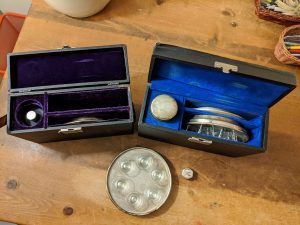As I mentioned last time, I bought two vintage portable communion kits from eBay sellers and this article shows what they contain. Readers who aren’t interested in the specifics of these particular items can skip over this article. If I left out a detail you were looking for, ask in the comments.
I ordered the kits thinking they were identical models and while very similar, this was not the case. Indeed, as only one is marked, so I can’t be sure that they are from the same maker — Sudbury Brass, which no longer makes a kit like this — but if they are, they must come from different periods of production.

The smaller kit is the model 1215, and from advertisements in ministers’ magazines seem to have been sold from about 1949 to 1955, perhaps longer. Other than a mark on the clasp of the case (SB 1215) the only markings are “silver on copper” on metal pieces. The larger case and its contents have no markings at all.
While the cases are different sizes, they contain essentially the same items, or did originally. Each has a shallow silverplate basin with a silverplate disc with six holes; this holds the six glasses. The one in the larger case is slightly larger and the disc lifts off easily, while the disc on the smaller one is more closely fitted: a bit harder to clean, but quieter. There is also a shallow bread plate; these are identical between the kits. (A loaf three inches in diameter would fit on the plate, but not in the kit.)
The smaller case with the purple lining has no bread box, but has a place for where it would have rested. The bread box would be suitable for host wafers, small pieces of bread sold to Protestants and perhaps oyster crackers. The smaller kit has its original wine flask, while the larger kit had the original silverplate cap awkwardly wedged onto a modern plastic bottle; they were not threaded the same. The silverplate on both caps is worn. The box and flask are not interchangable with the other kit, which brings us to the cases themselves.
Each seems to be made of masonite or some other hardboard covered with a coated paper or cloth, similar to what would be used in bookbinding. Each is subdivided into three compartments, lined with velveteen: blue in the large case and violet in the small. The combined glasses tray fits in one compartment; the plate in another, while the flask sits in a “well” under a flange that holds the breadbox. The small case originally had a leather strap, now lost; the larger has a metal handle, like those found on small tool boxes of the period.
There’s no room for anything else: candles, common cup, service book, cross or the like. You might slip in an icon card and a handkerchief, but otherwise what you see is what you can carry here.
I’ll be thinking about how you would use it next.




One Reply to “Opening the communion kits”